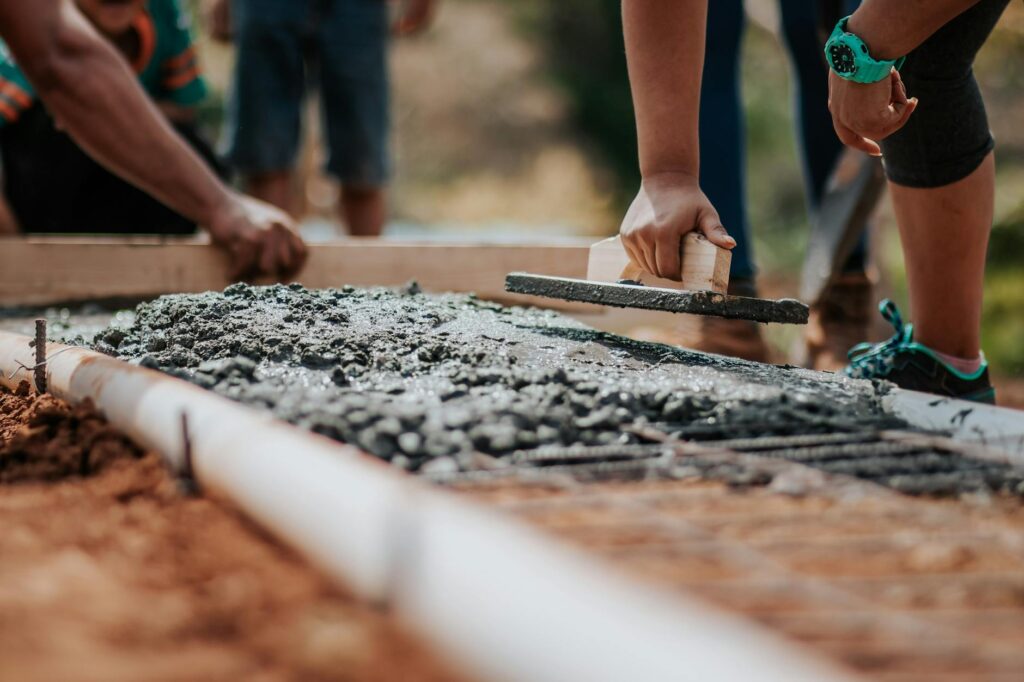Key Takeaways:
- Proper concrete installation is essential for commercial sidewalks’ safety, durability, and aesthetics.
- Quality materials and expert techniques ensure long-lasting sidewalks with minimal maintenance.
- Installing concrete correctly can prevent common issues like cracking and uneven surfaces.
Understanding the Basics of Concrete Sidewalk Installation
Over time, even a properly installed concrete sidewalk may face challenges due to weather exposure, heavy traffic, or soil movement. When these issues arise, uneven sidewalk repair becomes a critical solution to restore both safety and aesthetics. Addressing surface irregularities not only prevents potential trip hazards but also prolongs the overall lifespan of the structure, reducing the need for full replacement.
Concrete sidewalks are integral to urban landscapes, providing durability and versatility in design. When considering commercial concrete services, proper installation is key to maximizing these benefits. From preparing the subgrade to selecting the best concrete mix and finishing methods, the process requires careful planning and execution. A well-installed sidewalk can endure the test of time, enhancing both aesthetic appeal and functionality. However, inadequate installation can lead to issues such as cracking, shifting, or uneven surfaces, detracting from appearance and posing safety risks.
The Role of Quality Materials
The lifespan and quality of sidewalks are significantly influenced by the materials used. High-grade concrete mixes that match the environment’s specific needs—considering factors like climate and foot traffic—are essential. A too-rich or lean mix can lead to premature wear or structural failures. Incorporating additives that enhance durability, such as air entrainment agents, can significantly improve the concrete’s resistance to freeze-thaw cycles, a common issue in colder climates.
Transport and Handling Considerations
Once a suitable concrete mix is chosen, attention turns to its transport and handling. Timing is crucial; concrete must be transported efficiently to maintain workability upon site arrival. Prolonged transport times can lead to the initial setting, complicating the installation process. Proper handling also ensures the concrete is poured at the right temperature and moisture levels. Engineered admixtures can aid in controlling the setting time, allowing for adjustments in case of delays. Ensuring these elements are correctly managed safeguards against common issues like premature hardening or inadequate mixing.
Site Preparation and Subgrade Importance
Effective site preparation is fundamental to ensuring the stability and performance of the finished sidewalk. The subgrade, which serves as the foundation, must be properly compacted and leveled to prevent settling and surface unevenness. Installing a gravel base not only aids in drainage but also adds an extra layer of stability. Adequate compaction of the subgrade minimizes the risk of future sidewalk settling and cracking. The importance of this step cannot be overstated, as it lays the groundwork upon which the concrete’s long-term integrity depends.
Techniques for Perfect Finishing
The finishing phase of concrete sidewalk installation is where artistry meets function. Various finishing techniques, such as troweling, brushing, or stamping, are employed to create specific textures and designs. These finishes enhance the aesthetic appeal and contribute to the sidewalk’s safety by providing slip resistance. Attention to detail is essential during this phase because improper finishing can lead to aesthetic flaws and functional issues. Timing is crucial; finishes should be applied during the right stage of the setting process to achieve the desired outcomes.
Mitigating Common Problems
Proper installation techniques can mitigate many issues associated with concrete sidewalks, such as cracking and spalling. Employing control joints at appropriate intervals helps prevent cracking by allowing controlled concrete slabs movement. Ensuring the right water-to-cement ratio is used is crucial to prevent problems associated with excessive shrinkage. Monitoring the curing process, which includes appropriate moisture retention techniques like curing compounds or water spray, ensures the concrete reaches its full strength and durability potential, thus reducing the likelihood of surface defects.
Long-Term Benefits of Proper Installation
The advantages of correctly installed commercial sidewalks extend beyond immediate visual appeal. Proper installation results in a durable, low-maintenance surface that withstands heavy usage and adverse environmental conditions. This longevity translates to cost savings over time by reducing repair frequencies and extending the time between necessary maintenance interventions. Moreover, well-installed sidewalks enhance pedestrian safety and contribute to the urban environment’s aesthetic appeal, making public spaces more inviting and user-friendly.
Conclusion: The Foundation of Future-Friendly Sidewalks
In conclusion, investing in quality materials, meticulous installation practices, and expert techniques for sidewalk construction pays off in terms of safety, aesthetics, and longevity. As urban areas expand and demand more resilient infrastructure, utilizing comprehensive concrete installation methods becomes even more critical. The focus on foundational integrity in commercial sidewalks highlights the intersection of innovation, sustainability, and urban planning, ensuring that the sidewalks of today can meet the needs of tomorrow.

